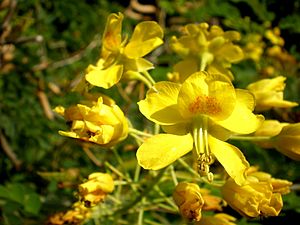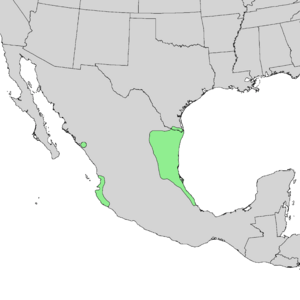Mexican holdback facts for kids
Quick facts for kids Erythrostemon mexicanus |
|
|---|---|
 |
|
| Scientific classification | |
| Kingdom: | |
| (unranked): | |
| (unranked): | |
| (unranked): | |
| Order: | |
| Family: | |
| Genus: |
Erythrostemon
|
| Species: |
E. mexicana
|
| Binomial name | |
| Erythrostemon mexicana (A.Gray 1861) E. Gagnon & G. P. Lewis 2016
|
|
 |
|
| Natural range | |
| Synonyms | |
|
|
The Erythrostemon mexicanus is a beautiful flowering plant that belongs to the pea family, called Fabaceae. You might know it by its common names like Mexican holdback or Mexican caesalpinia. In some places, it's also called tabachín del monte.
This plant naturally grows in the southern part of Texas in the United States. It also lives in many areas of central Mexico. You can find it along the Gulf coast and even on the Pacific coast in states like Nayarit, Jalisco, Colima, and a small part of Sinaloa.
What Does It Look Like?
The Mexican holdback can be a small evergreen tree or a large shrub. It usually grows to be about 3 to 4.6 meters (10 to 15 feet) tall. It can spread out about 1.8 to 3 meters (6 to 10 feet) wide.
Its leaves are dark green and have a special shape called bipinnately-compound. This means each leaf has smaller sections called pinnae. Each pinna is about 4 to 9 centimeters (1.5 to 3.5 inches) long. On each pinna, there are four to five tiny leaflets. These leaflets are about 1 to 2.5 centimeters (0.4 to 1 inch) long and 0.7 to 1.3 centimeters (0.3 to 0.5 inches) wide.
The plant produces lovely yellow flowers that have a light, sweet smell. These flowers grow on spikes that are about 7.6 to 15.2 centimeters (3 to 6 inches) long. Each spike can have 10 to 30 flowers. The Mexican holdback blooms from February to July, and sometimes even into October. After the flowers, it grows fruits. These fruits are tan or yellow seedpods that are about 5.1 to 7.6 centimeters (2 to 3 inches) long. They split open when they are ready to release their seeds.
Why Is It Used?
People often plant the Mexican holdback in their gardens. It's a popular ornamental plant because of its beautiful, bright flowers. Its leaves are also very attractive, with a fine texture. Another great thing about this plant is that it can handle dry weather, which makes it easy to care for in many places.
Ecology and Life Cycle
The Erythrostemon mexicanus plays an important role in nature. It is a special host plant for the caterpillars of a butterfly called the curve-winged metalmark (Emesis emesia). This means that the caterpillars eat the leaves of the Mexican holdback as their main food source. This helps the caterpillars grow and change into butterflies.

